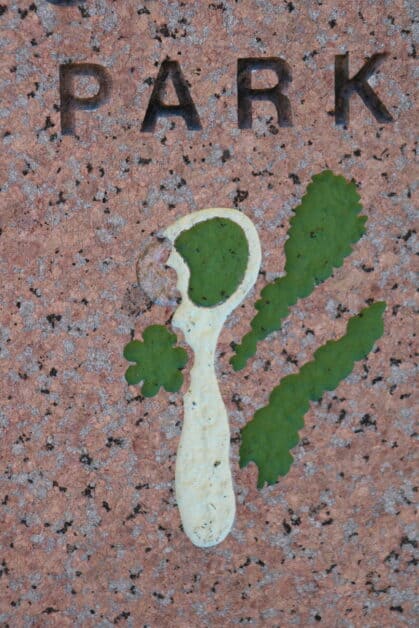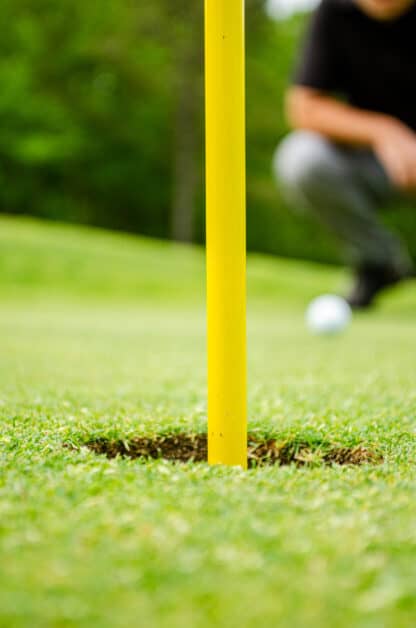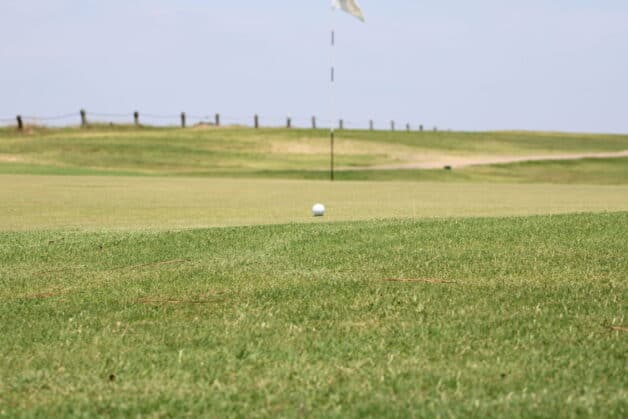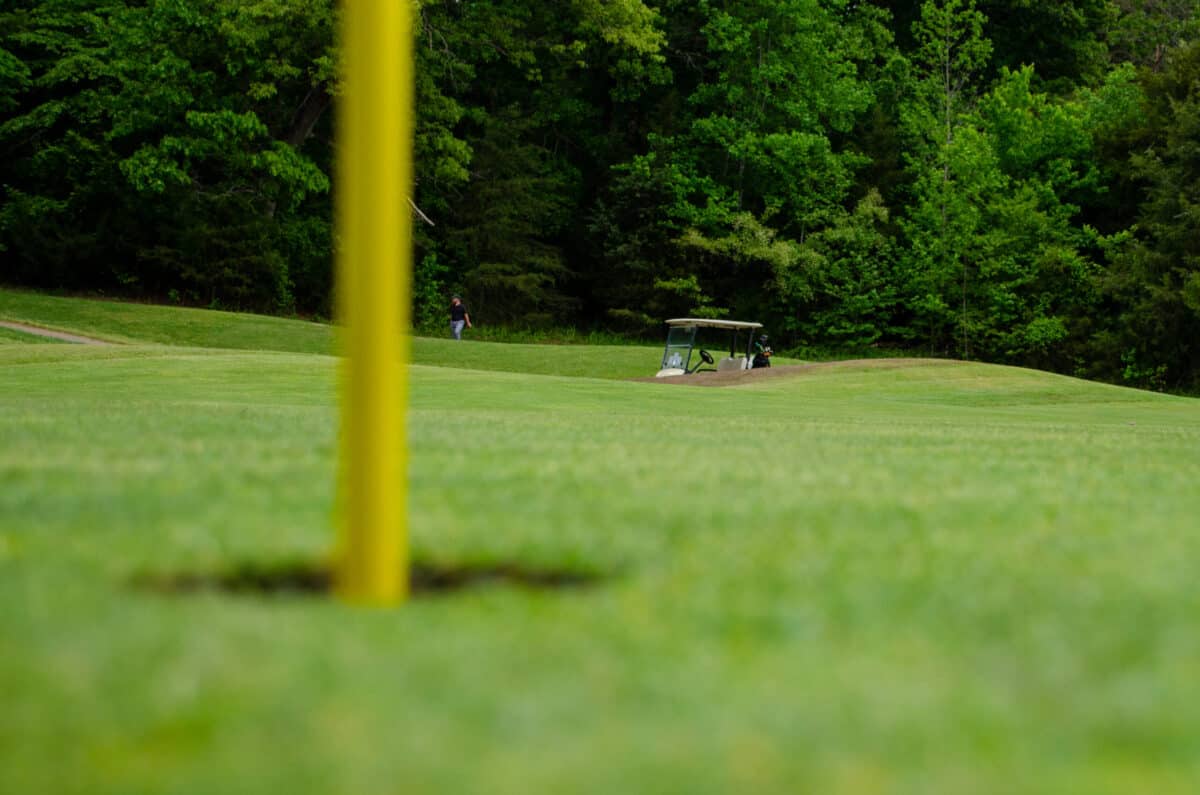There are many terms and abbreviations in golf terminology. Many of these terms are used throughout the game, but others are specific to certain situations. One of the most common abbreviations is E which stands for even and is used to keep track of the scores during a game. Even par can stand for the score on an individual hole, or a cumulative score during a round. Especially useful during a golf tournament.

The most simplified way to understand the use of E is when thinking about a specific hole. It can be a par 3, par 4 or par 5. Let’s use a par 3 for an example. If a golfer has a score of 2, that would be a birdie. But if that golfer has a score of 3, that would be a par. And by scoring a par, he would be at even par for the hole. Which is abbreviated to E.
Similarly if the golfer scored a hole in one, he would be -2 for that hole. Or if he scored a bogey 4, he would be +1 for the hole.
For events on places like the PGA Tour, the golf tournament leaderboard will display the scores in this +/- or E during the round as a simple and easy way to score the tournament. Instead of showing the number of strokes, the leaderboard shows the par number for each golfer
When golfers participate in a match, one person will have a plus next to their name, meaning beating their opponent. If this golfer gets a score of even, their opponent will get the minus sign. The golfer who has the minus sign is trying to beat their opponent by two strokes. One of the ways to keep score in golf.
When Will I Use an E for Even Par on My Scorecard?
During match play, most golfers will use the letter E when they get a score of even. With this, it is easy to keep track of each player’s score at all times.

If you are playing a match involving multiple players, it is important to keep track of them.
When Will I Not Use an E on My Scorecard?
Even though E is typically used when golfers score even, there are some occasions where you will not use the letter. For example, scores that end in zero (0) should not include an E. This is because the number zero (0), when used as a score, means that the golfer has won. The opposite of this would be a “double bogey” or “+2.” In this situation, you took two strokes, and you can’t have an E for that.
In team play, each hole is scored individually. So, for instance, if a team gets a score of six on the first hole but scores an eight on the second hole, they would have two eights on their scorecard. This means that they are two holes down to their opponents.
When golfers are allowed to “redo” or redo the shot, they get to take another shot instead of keeping their original score. So if the golfer had gotten a double bogey on that first hole, they would be allowed to take another shot at it. The golfer would get an E on their scorecard for the second attempt because it wouldn’t be counted as a bogie since they used a do-over.

What other letters are used for the number of strokes in golf?
You can use some other letters and abbreviations for keeping track of scores, but they are not as common. For example, when a golfer gets a double eagle (three under par), it is typically written as an E. Also, if you get to “redo” your score due to a penalty or “mulligan,” you will add an A to the front of your score. This represents the term “again.”

What Does Up Mean In Golf?
In Match Play, when a golfer leads his opponent in the match, they are said to be up. A golfer who is 2-up, for example, leads their opponent by two holes. That means that they have beaten them twice as often as his opponent has beaten him. The goal in match play is to be up by more holes than remaining to play after the game. When this happens, the player who is up will win, and the game will conclude.
The term may also describe the overall score of a game played in match play format. Indeed, if a golfer wins the final hole of a round while the match is still even at the tee, he will win the match. His opponent will be labeled 1-up. A golfer who wins the last hole after debuting it ahead already 2-up will win his game. He’ll get credit for winning 2-up.
What Does Down Mean In Golf?
In Match Play, when a golfer is trailing his opponent, he is said to be down. For example, if a golfer is 2-down against his opponent, he trails him by two holes. That implies that his opponent has defeated him twice as many times as he has beaten this opponent.
The losing golfer in a match will try to win holes to balance out the ones he’s lost. He’ll want to do so as soon as possible before there are no more holes left to play, at which point the game ends, and the player who is down has lost.
What Does All Square Mean In Golf?
A match is all square when tied, i.e., when no player has a lead in the match. This can happen when neither golfer nor the team has managed to win a single hole. It can also happen if the number of holes won by each golfer or team is equal, meaning that both golfers or teams have won the same amount of holes.

For example, if a golfer wins the first hole but loses the second, the match will remain level as the two golfers tee up on hole #3. Similarly, a game that ends in a tie among the first two holes will be recorded as all square because the golfers will tee up on hole #3. If a game goes back to being all square after this, the scorer on the scorecard will usually use the initialism ‘AS.’
What Does E Mean In Golf: Expand Your Golfing Vocabulary
Golf is a game where you can’t rely on luck. It’s much more about skill, strategy, and outsmarting your opponent to win the match. All these elements are reflected in the scores you see on scorecards. E is typically used to indicate when a golfer gets an even on the whole.
The A stands for “again,” which indicates that the player used his do-over or had some form of penalty and will get another chance at it before keeping the initial score. Up and down also play significant parts in match play, with up typically indicating that a golfer has won more holes than their opponent while down tells us that the opponent has won more holes than he has lost.
All square is typically used when there’s no lead after multiple rounds of golf have been played to avoid drawing unnecessary attention from onlookers toward particular players who may be playing well or poorly.
- Should Tee Boxes Be Level? - January 23, 2024
- 3 Hybrid Distance - November 15, 2023
- Innovations in Golf Mobility: An In-depth Review of Top Golf Scooters - October 12, 2023
